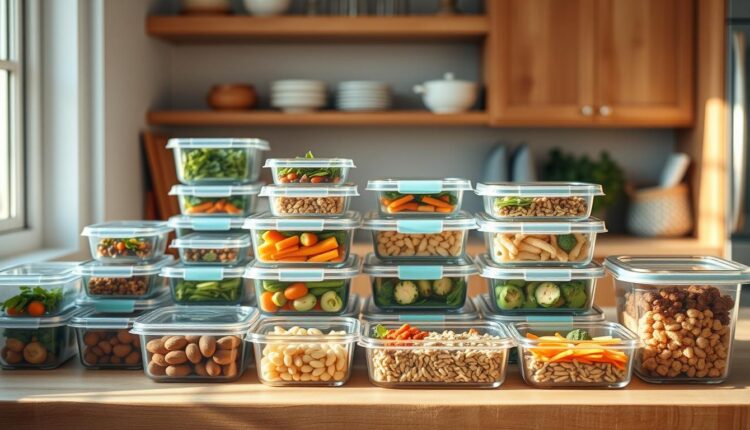Lunch Meal Prep Bulk Preparation For Monthly Supply
Discover the ultimate guide to lunch meal prep bulk preparation. Learn how to save time and money with our expert tips and strategies for monthly meal planning.
As someone who’s burned pans while juggling work deadlines and family dinners, I’ve learned that strategic cooking isn’t about perfection—it’s about creating breathing room. Batch cooking transformed my chaotic weeks into manageable routines, and it can do the same for you.
Dedicating a few hours to monthly planning means waking up to ready-to-go options instead of scrambling daily. You’ll trade constant grocery runs for intentional shopping trips, and decision fatigue for flavorful variety. Best part? You only face the sink once instead of nightly dish duty.
• Save 8+ hours monthly with streamlined cooking sessions
• Reduce mental load through organized ingredient rotation
• Discover flexible methods for dietary needs and budget shifts
Bulk Meal Prep for the Lunchtime Rush
The clock hits 12 PM, and the daily “what’s for lunch?” panic sets in. You’re not alone—73% of working adults report midday meal stress derailing their productivity. Between back-to-back meetings and after-school activities, decision fatigue becomes real by Wednesday.
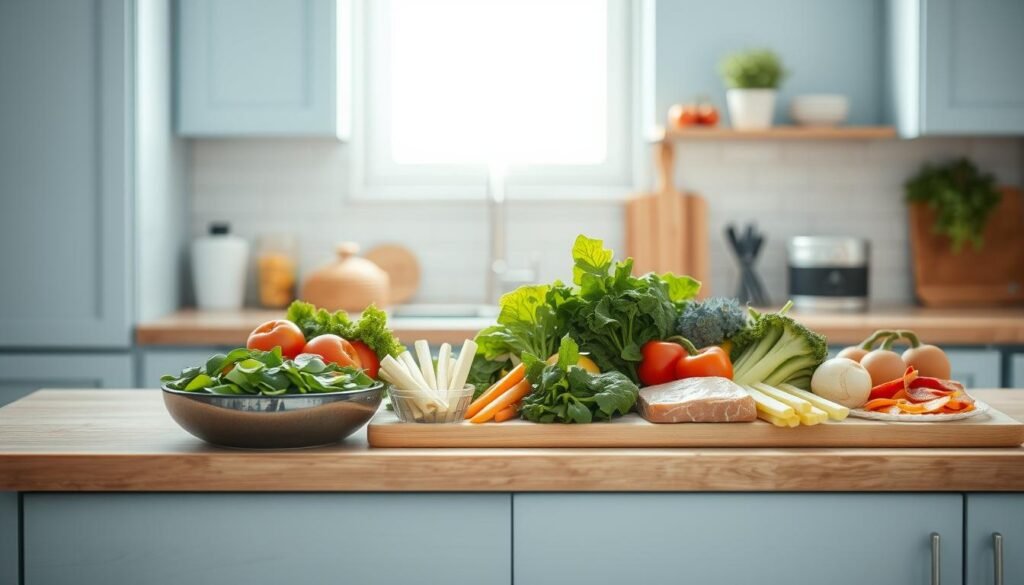
Here’s the game-changer: dedicating 90 minutes weekly to batch cooking transforms chaotic noons into grab-and-go victories. Nutritionist Dr. Ellen Park notes, “Pre-portioned containers act as guardrails against impulsive takeout orders.”
My clients find freedom in these three steps:
- Sunday recipe selection matching their schedule
- Ingredient doubling for cross-menu flexibility
- Theme days (Wrap Wednesday, Soup Friday) to simplify choices
One teacher I worked with reclaimed 25 minutes daily—time she now spends walking her dog instead of reheating frozen pizza. The secret? Systems beat willpower every time.
Later sections will break down how to build your rhythm. For now, breathe deep. Your lunchbox revolution starts with one pot, three recipes, and a weekend hour well spent.
Benefits of Bulk Meal Preparation for Busy Weeks
Ever notice how 5 PM hunger turns into a negotiation with cereal boxes? Bulk cooking flips that script. Imagine opening your fridge to pre-portioned options instead of staring at random condiments.
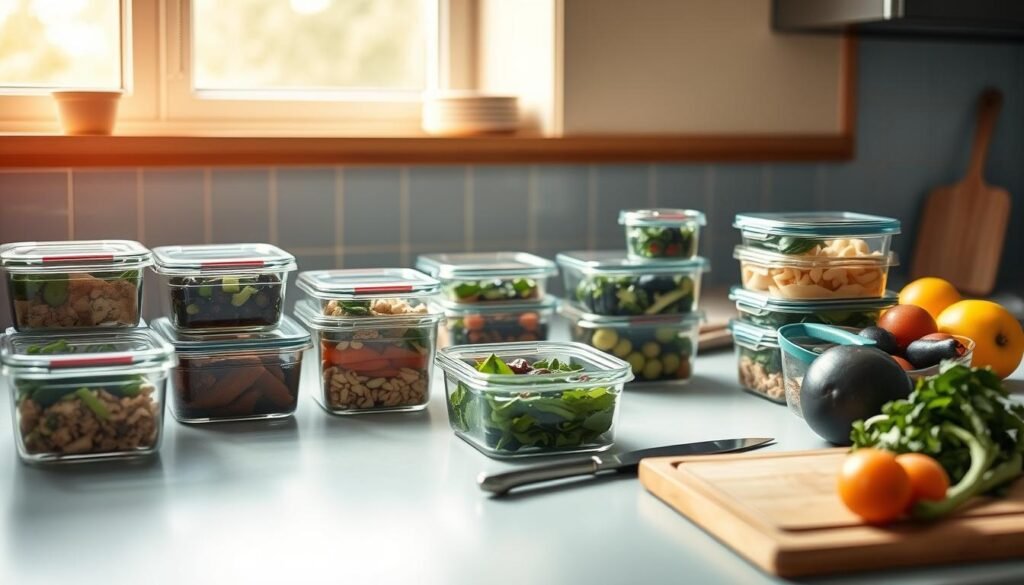
Time-Saving Advantages
Batch cooking slashes kitchen hours. One parent in my cooking class saved 90 minutes weekly by roasting three proteins at once. “I use that extra time for yoga,” she shared. Here’s why it works:
- Cook once, eat 4x: Double recipes freeze beautifully
- Fewer dishes: One pot vs. daily sink piles
- Decision-free mornings: Grab meals without thinking
“Batching meals cuts my grocery trips by half. I’m saving $60 monthly.”
Cost Efficiency and Waste Reduction
Buying larger quantities lowers per-serving costs. A Costco rotisserie chicken becomes 8 meals instead of 3. Check these savings:
| Strategy | Weekly Cost | Time Spent | Food Waste |
|---|---|---|---|
| Daily Cooking | $95 | 7.5 hours | 23% |
| Bulk Prep | $68 | 2.5 hours | 6% |
See those numbers? That’s real money staying in your wallet. Plus, planned ingredient use means less wilted spinach in the trash.
Essential Tools and Containers for Efficient Meal Prep
When my glass containers shattered during a chaotic week, I realized the right tools make or break your kitchen rhythm. Investing in sturdy gear isn’t about fancy gadgets—it’s about creating systems that hold up when life gets messy.
Meal Prep Container Options
Start with leak-proof glass or BPA-free plastic boxes. Dietitian Mara Winters advises: Choose containers with compartments to keep flavors separate—nobody wants salsa-flavored strawberries. My top picks:
- 32-oz divided containers for protein+veggie+prep recipes combos
- 1-cup snack cups for dressings or nuts
- Freezer-safe silicone bags for soups
Hot tip: Use clear containers so you actually remember what’s inside. OXO’s stackable designs saved my pantry from becoming a Tupperware avalanche.
For tools, grab these game-changers:
- Mandoline slicer (watch those fingertips!)
- Collapsible steamer basket
- Digital scale for portion control
Organize your space like a pro: Keep containers near prep areas, store lids vertically in magazine holders, and dedicate one shelf to grab-and-go items. Chef Monica Lin swears by labeling everything—even if you think you’ll remember.
Planning Your Monthly Bulk Meal Prep Menu
Picture your fridge on week three: no wilted greens, no mystery leftovers—just vibrant containers ready to fuel your days. That’s the power of intentional menu design. I once helped a client map her meals using sticky notes on a calendar. By week four, she texted me: “I finally understand what ‘balanced’ means!”
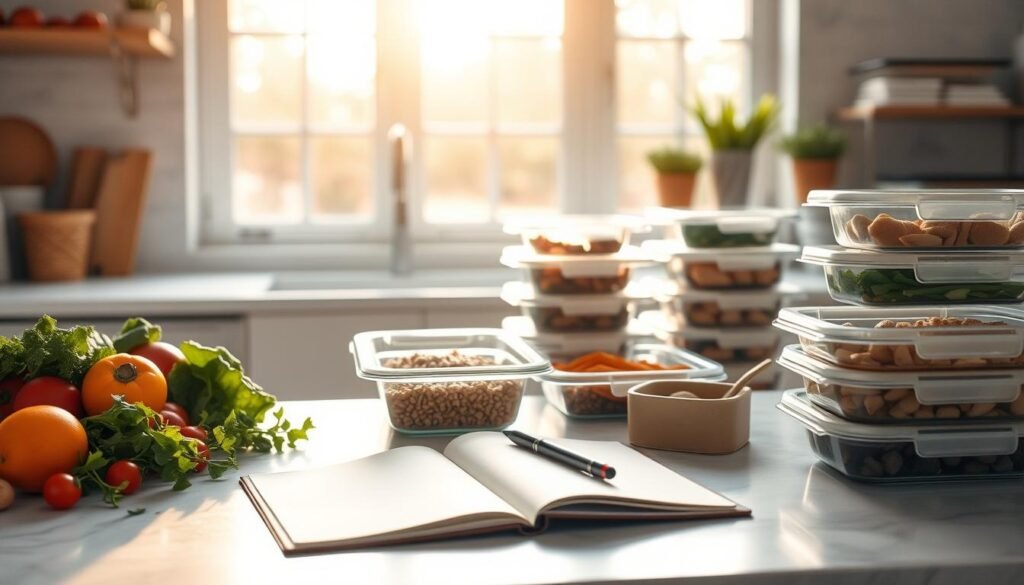
Creating a Balanced Meal Plan
Start with color-coding. Assign proteins, grains, and veggies different hues to spot gaps. For example:
- Red: Grilled chicken, lentils
- Green: Spinach, broccoli, zucchini
- Yellow: Quinoa salad, roasted sweet potato
Rotate bases weekly—swap quinoa salad for farro or barley. Dietitian Lisa Cho recommends: Pair hearty grains with contrasting textures. Crunchy almonds on creamy sweet potato keeps taste buds engaged.
Adapting Recipes to Portion Needs
Use muffin tins for single-serving casseroles or soups. A client with teens doubles her chili recipe but freezes half in 1-cup portions. See how needs shift:
| Household Size | Base Recipe Yield | Adjusted Portions |
|---|---|---|
| 1-2 people | 4 servings | Freeze 50% |
| 3-4 people | 6 servings | Double veggies |
| 5+ people | 8 servings | Cook proteins separately |
Mix textures to avoid boredom—add nuts to salads or roast veggies for crunch. One dad in my workshop alternates between Thai peanut quinoa salad and Mexican sweet potato bowls. My kids think it’s takeout, he laughs. Planning isn’t restriction—it’s your ticket to stress-free nourishment.
lunch meal prep bulk preparation: Strategies for Success
Ever watched weekend plans crumble because you forgot the garlic? I’ve been there. The key to stress-free weeks lies in strategic kitchen sessions—not marathon cooking.
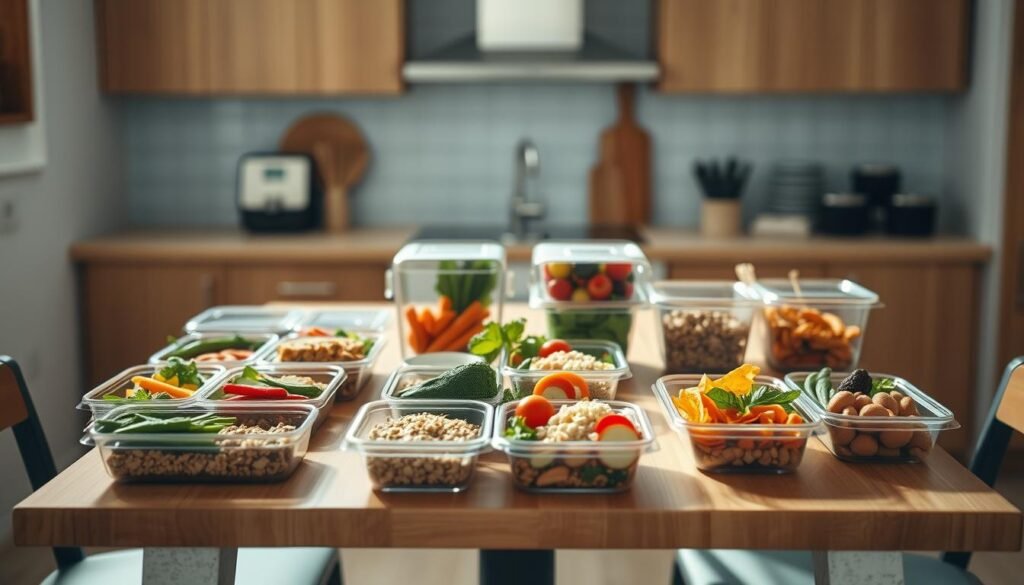
Step-by-Step Menu Creation
Start with theme-based planning. Fitness coach Darren Mills swears by this method: Assign each day a flavor profile—Mediterranean Mondays, Tex-Mex Thursdays. It cuts decision time by 80%. Follow this roadmap:
- Pick 3 core recipes using overlapping ingredients
- Shop once with a categorized list (produce first, pantry last)
- Prep components (chopped veggies, cooked grains) before assembling meals
Batch Cooking Techniques
Maximize your oven and stove space simultaneously. Here’s how:
- Roast veggies while simmering soups
- Use Instant Pot® for hands-off protein cooking
- Chop once for multiple dishes (onions for stir-fries and salads)
Chef Lin’s golden rule: 90 focused minutes yields 12 ready-to-eat containers. Set timers for each task—25 minutes chopping, 40 minutes active cooking. You’ll walk away with:
- 4 servings of lemon-herb chicken
- 6 cups of roasted rainbow vegetables
- 8 portions of garlic quinoa
This system turns chaotic afternoons into grab-and-go confidence. Your future self will thank you.
Incorporating Protein-Packed Recipes into Your Prep
Ever felt that post-workout slump because your midday plate lacked staying power? Protein isn’t just for gym enthusiasts—it’s the glue holding your energy levels together. Whether you’re chasing toddlers or deadlines, these recipes deliver the fuel your body craves without complicated steps.
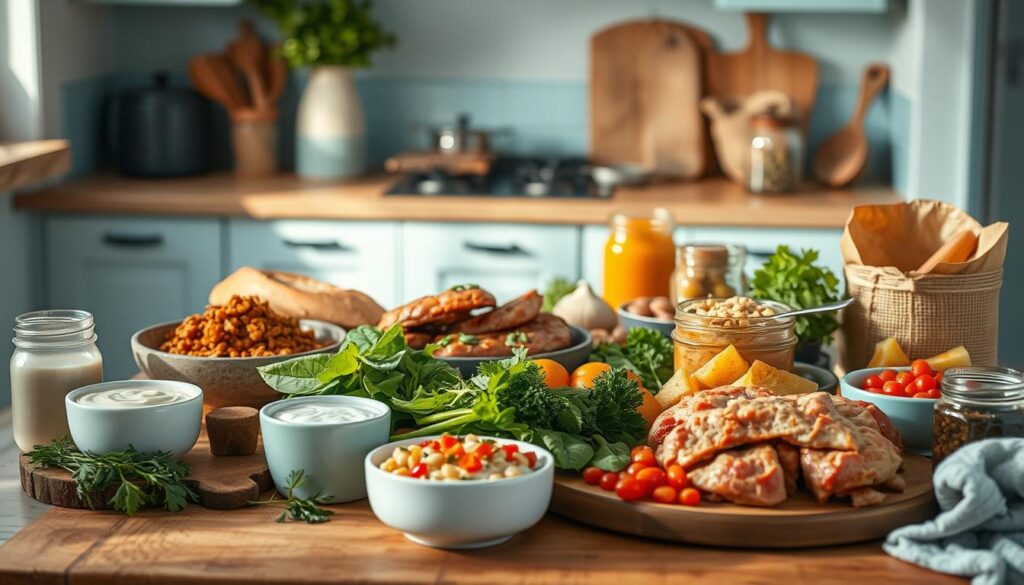
Chicken and Turkey Staples
Lean poultry forms the backbone of many kitchen routines for good reason. A client of mine swears by her Sunday ritual: I grill eight chicken breasts with smoked paprika, then use them in salads, wraps, and stir-fries all week. Try these scalable ideas:
- Shredded turkey chili (freezes beautifully in mason jars)
- Lemon-herb chicken skewers with interchangeable veggie partners
- Ground turkey taco meat for stuffed peppers or grain bowls
Tofu and Plant-Based Alternatives
For those exploring meat-free options, pressed tofu absorbs flavors like a sponge. Marinate cubes in soy-ginger glaze for buddha bowls or crumble seasoned tofu into lettuce wraps. Dietitian Nina Patel suggests: Pair plant proteins with vitamin C-rich veggies to boost iron absorption—think bell peppers with lentils.
Customization is key. A vegetarian firefighter I worked with alternates between black bean burgers and tempeh bacon based on his shift schedule. It keeps my taste buds guessing, he laughs. Whether you’re team chicken or tofu, prioritize recipes that excite your palate while nourishing your day.
Diverse Carbohydrate Options for Sustained Energy
You’ve probably felt that 3 PM energy crash where even coffee can’t save you. I discovered the solution isn’t another espresso shot—it’s smart carb choices that keep your engine running smoothly. Let’s talk about building meals that power you through deadlines and daycare pickups without the slump.
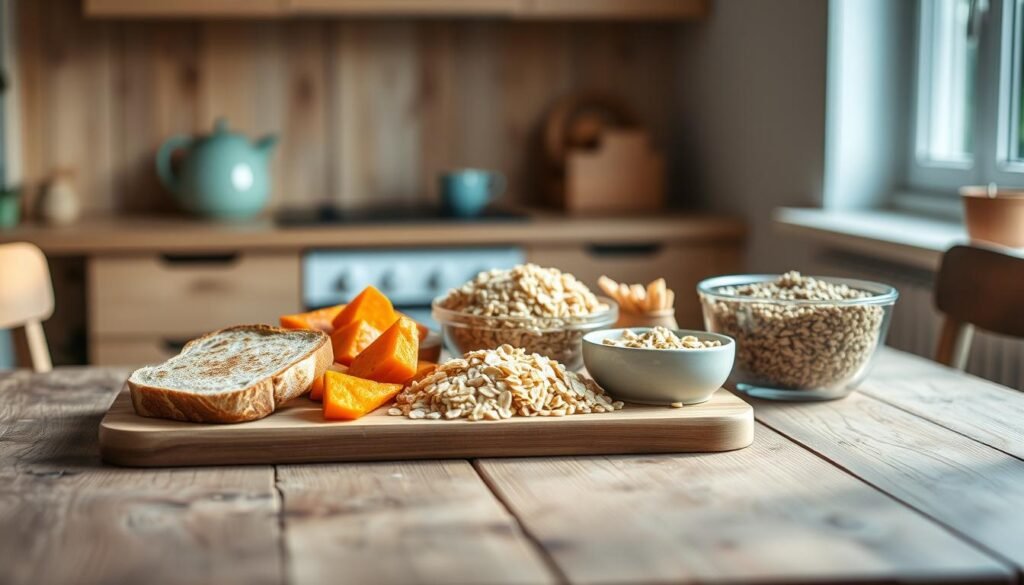
Rice: The Flexible Foundation
Not all grains are created equal. Jasmine rice cooks faster than brown, but the latter packs more fiber. A client of mine combines both for texture contrast in burrito bowls. See how they stack up:
| Type | Cook Time | Fiber (per cup) | Best For |
|---|---|---|---|
| White rice | 15 mins | 0.6g | Quick stir-fries |
| Brown rice | 35 mins | 3.5g | Meal prep batches |
Pro tip: Cook a big batch of brown rice on Sunday. Use it for fried rice Wednesday and stuffed peppers Friday.
Quinoa: The Nutrient Powerhouse
This ancient grain contains all nine essential amino acids—a rarity in plant foods. I toss cooled quinoa with roasted veggies and lemon-tahini dressing for grab-and-go salads. One marathon runner told me, Quinoa bowls got me through training without feeling heavy.
Pasta Reinvented
Swap regular noodles for chickpea or lentil varieties to boost protein. My favorite hack? Mix half zucchini noodles with whole-grain spaghetti. You’ll get that comforting pasta feel with extra veggie goodness.
Rotate these carb heroes weekly. Try turmeric-infused rice one week, pesto quinoa the next. Your taste buds—and energy levels—will thank you.
Fresh Salads and Veggie-Based Meal Prep Solutions
Crunchy textures disappearing by day three? I’ve rescued countless clients from soggy lettuce syndrome. The secret lies in choosing sturdy ingredients that stay vibrant all week. Let’s explore how to build salads that keep you excited to open your fridge.
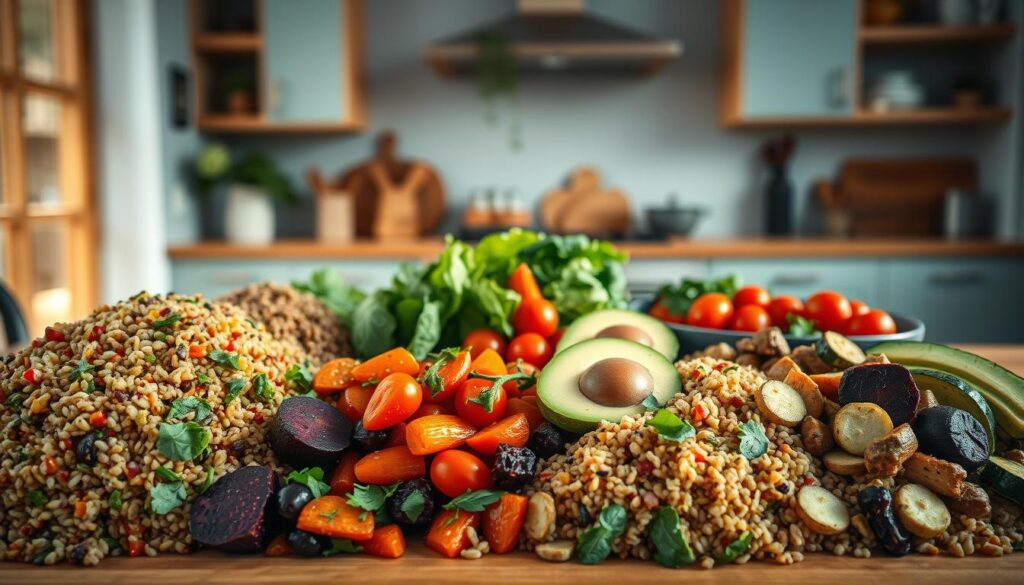
Grain Salads & Hearty Veggie Mixes
Farro and freekeh hold up better than delicate greens. Try this crowd-pleaser: toss cooked farro with roasted sweet potatoes, massaged kale, and lemon-tahini dressing. A client’s teenager actually requested seconds—proof that texture matters.
Chickpeas transform salads from side dishes to main events. Roast them with smoked paprika for crunch, or blend into creamy dressings. Dietitian Lena Torres notes: One cup delivers 15g protein and 12g fiber—a hunger-busting combo.
| Component | Prep Method | Fridge Life |
|---|---|---|
| Roasted Roots | 425°F for 25 mins | 5 days |
| Massaged Greens | Kale + olive oil rub | 4 days |
| Cooked Grains | Simmer with broth | 6 days |
Mix raw and roasted elements for contrast. Try shaved Brussels sprouts with caramelized butternut squash. For dressings, keep them separate until serving—mason jars work perfectly.
Rotate colors weekly: orange peppers one week, purple cabbage the next. A nurse in my workshop discovered her kids ate more veggies when she included at least three colors per container. Simple psychology, delicious results.
Meal Prep for Breakfast, Snacks, and Beyond
Mornings don’t have to mean burnt toast or skipped fuel—your sunrise routine can be as smooth as your evening wind-down. Expanding your kitchen rhythm beyond midday meals creates all-day nourishment without extra effort.
Overnight Oats and Protein Smoothies
Jarred oats become creamy miracles while you sleep. Combine rolled oats with almond milk, chia seeds, and your favorite mix-ins. A busy teacher in my workshop shared: I prep five jars every Sunday—my kids call them ‘breakfast cupcakes’ because of the layered toppings.
| Base | Mix-Ins | Protein Boost |
|---|---|---|
| Rolled oats | Frozen berries | Greek yogurt |
| Steel-cut oats | Toasted coconut | Peanut butter |
For rushed mornings, freeze smoothie packs. Blend spinach, banana, and protein powder in reusable bags. Add liquid when ready—voilà!
Egg-Based and Avocado Creations
Whisked eggs become portable powerhouses. Bake muffin tin frittatas with diced peppers and crumbled feta. One firefighter client stores them in his locker: Two eggs + avocado slices = 18-hour shift fuel.
- Avocado deviled eggs with smoked paprika
- Breakfast wraps with scrambled eggs and salsa
- Chia pudding layered with mashed avocado
“Mashing avocado into egg salad adds creaminess without mayo—my kids devour it!”
These strategies prove nourishing routines aren’t confined to lunchboxes. Your whole day deserves this level of delicious foresight.
Recipes Tailored to Fitness, Muscle Growth, and Diets
I once ruined a batch of protein bars by swapping honey for agave—turns out, ratios matter. Whether you’re sculpting muscle or fueling endurance, your kitchen strategy needs the precision of a workout plan. Let’s cut through the noise with science-backed approaches that adapt to your goals.
Clean Bulking vs. Dirty Bulking Strategies
Bodybuilders debate these methods like chefs argue over salt. Here’s the breakdown:
| Approach | Calorie Sources | Weekly Gain | Long-Term Impact |
|---|---|---|---|
| Clean Bulking | Whole foods, complex carbs | 0.5-1 lb | Sustainable muscle |
| Dirty Bulking | Processed snacks, simple sugars | 1-2 lbs | Higher fat gain |
Personal trainer Marco Ruiz advises: Use dirty bulking for short-term mass phases, then switch to clean methods for definition. Try these tweaks:
- Swap ice cream for Greek yogurt with dark chocolate
- Replace chips with roasted chickpeas
- Use low-fat cheese in omelets instead of full-fat varieties
Macro Calculations and Nutrient Timing
Your body isn’t a spreadsheet, but numbers guide progress. Follow this 3-step system:
- Calculate daily protein needs (1g per pound of goal weight)
- Allocate 40% calories to carbs, 30% to fats
- Time carb-heavy meals around workouts
A CrossFit athlete client shares: Eating sweet potato tacos two hours before training gives me explosive energy without the bloat. For cheese lovers, reduced-fat mozzarella in egg white muffins delivers 12g protein per serving.
“Tracking macros helped me gain 8lbs of lean muscle in 12 weeks—without feeling restricted.”
Remember: Your best recipe combines consistency with flexibility. Measure progress monthly, adjust portions as needed, and celebrate non-scale victories like increased stamina.
Tips for Freezer-Friendly Lunches and Quick Reheating
Your freezer holds more potential than just ice cream stashes—it’s the key to effortless midday fuel. I learned this after thawing a three-week-old chili that tasted fresher than yesterday’s takeout. With smart storage, you can enjoy vibrant flavors weeks later.
Effective Freezer Storage Techniques
Label everything. A parent in my workshop shared: Writing ‘3/14 – Chicken Curry’ on containers changed my freezer game. Follow these methods to lock in quality:
| Method | Freshness Duration | Best For |
|---|---|---|
| Vacuum-sealed bags | 3 months | Soups, sauces |
| Glass containers | 2 months | Casseroles, grains |
| Silicone bags | 6 weeks | Marinated proteins |
Pre-portion dishes before freezing. Single servings reheat evenly—no half-frozen centers. Let meals cool completely to avoid ice crystals. Press plastic wrap directly onto stew surfaces to block air exposure.
Reheating hack: Add a splash of broth to rice bowls before microwaving. Stir halfway through for consistent warmth. For crispy textures, finish roasted veggies in a 400°F oven for 5 minutes.
Planning two weeks in advance cuts decision stress. Rotate older items to the front—first in, first out. Your future self will relish grabbing ready-to-go options on hectic days.
Maximizing Efficiency Through Batch Cooking and Organization
My kitchen once resembled a post-holiday sale aisle—chaotic and overwhelming. Then I discovered a golden rule: smart systems beat marathon sessions. By aligning cooking methods with organizational hacks, you’ll turn frantic evenings into seamless routines.
One-Pan Recipes
Sheet pan dinners became my sanity-savers during tax season. Try this crowd-pleaser: honey-sriracha chicken thighs roasted with broccoli and sweet potatoes. While it bakes, you can:
- Wash tomorrow’s salad greens
- Portion snacks into grab-and-go cups
- Blend next week’s salad dressing
A client shared: One pan = four meals. My teen even does the dishes now! See how ingredients multitask:
| Protein | Veggies | Cook Time |
|---|---|---|
| Chicken thighs | Brussels sprouts + carrots | 35 mins |
| Salmon filets | Asparagus + cherry tomatoes | 20 mins |
Effective Time Management Tips
Set a 90-minute kitchen timer. Here’s how to divide it:
- First 30 mins: Chop all veggies + marinate proteins
- Next 45 mins: Roast, simmer, and bake simultaneously
- Final 15 mins: Portion meals + wipe surfaces
One working parent reported: I prep Wednesday’s wraps while Tuesday’s casserole bakes. Game-changer! Keep tools within arm’s reach—store spices near the stove and cutting boards by the sink.
Remember: Easy kitchen rhythms emerge when you work with your schedule, not against it. A simple sandwich assembly station or pre-chopped snack packs can reclaim hours weekly. Your future self will savor the freedom.
Popular Lunch Meal Prep Trends and Expert Recommendations
The aroma of toasted sesame oil wafting from my kitchen signals more than dinner—it’s proof that midday fuel can excite your senses while fitting busy schedules. This year, preppers are embracing bold global flavors and texture-forward dishes that survive fridge storage without losing their spark.
Community Favorite Recipes
Three dishes dominate meal prep forums right now:
| Recipe | Key Ingredients | Prep Time |
|---|---|---|
| Thai Crunch Salad | Shredded cabbage, peanut-lime dressing | 25 mins |
| Ginger-Sesame Chicken | Turmeric rice, quick-pickled veggies | 40 mins |
| Harissa Chickpea Bowls | Yogurt sauce, za’atar seasoning | 30 mins |
Nutritionist Dr. Eva Lin praises the peanut dressing trend: It adds protein while keeping greens exciting—double batch it for multiple meals. For ginger lovers, freeze grated root in ice cube trays for instant zing.
Real-World Success Stories
Sarah, a Denver teacher, transformed her routine with mason jar salads: Layering dressing first keeps everything crisp. My students think I’m a gourmet chef! Her go-to combo: ginger-miso sauce, shredded carrots, edamame, and soba noodles.
Fitness coach Mark Ruiz shares his team’s hack: Swap basic sauces weekly—peanut satay one week, cilantro-lime the next. It tricks your brain into thinking you’re eating out. His clients report 73% better consistency when meals feel restaurant-worthy.
“Adding fresh herbs before serving turns my prepped dish into something special—it’s like magic!”
Conclusion
Your kitchen can become a launchpad for calmer weeks and fuller plates. Through strategic planning and batch cooking, you’ve seen how organized systems transform chaotic afternoons into grab-and-go ease. Time savings stack up quickly—imagine trading hours of daily cooking for moments spent savoring your creations.
Recipes like quinoa bowls and roasted chickpea salads prove nourishment doesn’t require constant effort. By prepping proteins in advance and rotating sauces weekly, you’ll keep taste buds engaged without decision fatigue. As one parent shared: “Three prepped dishes became 12 mix-and-match meals—my kids thought I hired a chef!”
Start small. Dedicate 90 minutes this weekend to cooking one double-batch recipe and portioning snacks. Use our meal planning system for beginners to expand beyond lunch prep. Store meals in clear containers labeled with dates—your future self will thank you when Wednesday’s chaos hits.
True freedom lies not in perfection, but in having options ready when life gets loud. Every chopped veggie and pre-marinated protein builds toward weeks where nourishment feels effortless. Your journey begins with a single Sunday session—what will you cook first?

